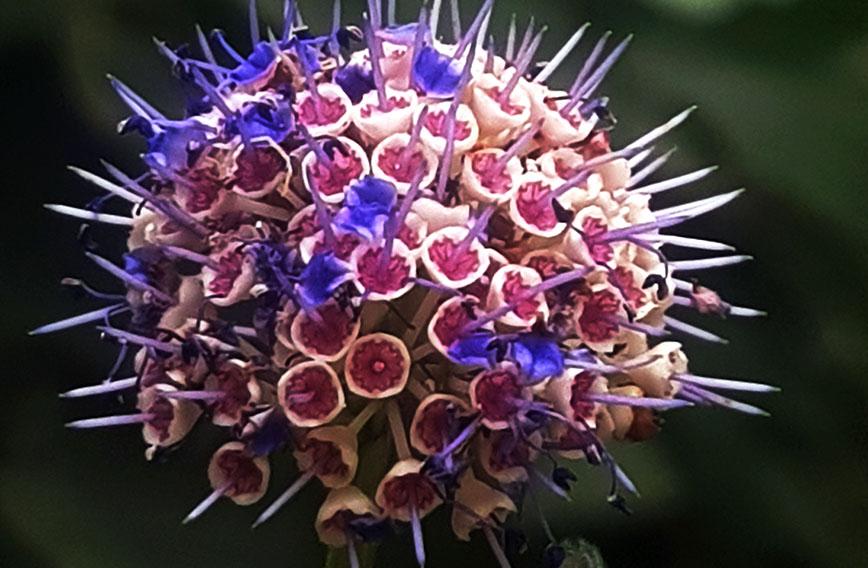
A wild plant Power list
Modern pharmacology draws on folk knowledge of medical plants. It is an old debt that remains unpaid.
Even so, folk remedies remain a primary source of treatment for millions.
Indian systems of medicine document 6,000 plants. Of them, 2,000 are codified for the actions they have in the human body.
To celebrate holistic medicine we bring you a power list of wild plants that are used to treat a range of disorders. Each plant has its own story. It has its own botanical and folk names.
There are of course many more and these are from a much larger list provided by Ganesh Babu.
You will find 1,500 of these plants alive and well in the herbal garden of the Foundation for the Revitalization of Local Health Traditions (FRLHT) in Bengaluru. And all 6,000 are documented in its herbarium.
 Ulat Kambal
Ulat Kambal
This lovely flower enchants you with its warm hues. It’s called Ulat Kambal, which means inverted blanket in Hindi, an allusion to its drooping flowers and soft texture. Scientifically known as Abroma augusta, it is found across the tropical forests of the Northeast and along the country’s east coast. Ulat Kambal is useful in healing irregular menstruation, polycystic ovarian syndrome and thyroid disorder.
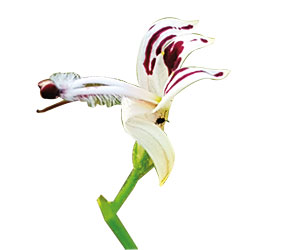 Nelabevu
Nelabevu
With its hooded white flowers spiked with purple tinges, Nelabevu looks artistic. It can enhance the colour palette of a garden. Nelabevu means herbaceous neem tree in Kannada, a reference to the plant’s bitter-tasting properties. This flower's official, botanical name is Andrographis paniculate.
Nelabevu’s petite flowers arranged on a stalk look like tiny birds sitting on tender branches. Densely packed racemose flowers can be gifted as seasonal bouquets. When planted in clumps its numerous stems and flowering twigs add colour to the landscape. Nelabevu is used to prevent dengue and to combat influenza, itching due to poisonous bites, wounds, ulcers, and chronic fevers, malarial and intermittent fevers, inflammation, skin disease, intestinal worms, diarrhoea and dysentery.
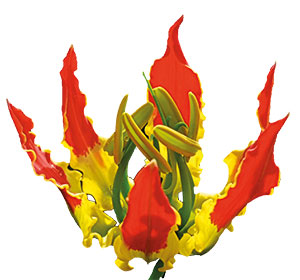 Kaanthal
Kaanthal
Kaanthal is the State Flower of Tamil Nadu. A poem on 99 flowers, found in Kurinji Paattu, a genre of Sangam literature, begins with the name Kaanthal, illustrating the importance of this plant. Kaanthal’s botanical name is Gloriosa superba. The words ‘glory’ and ‘superb’ in its botanical name rightly describe the beauty of this wild flower.
The flower’s striking arrangement of five red-tipped yellow petals are often compared with a lady’s fingers decorated with henna in Tamil literature. The stamens of Kaanthal are very distinct, being four cm long with conspicuous rotating anthers. Kaanthal is also called Flame Lily. It is commonly found in tropical thorn forests and along wayside thickets near foothills. The flower blooms immediately after the monsoon.
In our traditional systems of medicine, Kaanthal is used for treating skin diseases, intestinal worms, chronic ulcers, leprosy, cancer, head lice and as an antidote for poisonous bites.
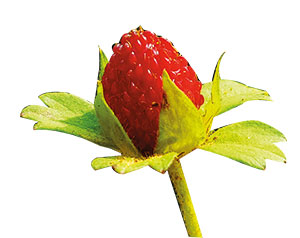 Indian Strawberry
Indian Strawberry
With its red berry, yellow flowers and green petals, the Indian Strawberry is a pretty sight. The plant’s botanical name is Potentilla indica. This flowering herb is a creeping, perennial which, when planted, covers the ground like a carpet. Its branches are reddish in colour with solitary yellow flowers two cm across in size with five petals.
The Indian Strawberry is cultivated for its fruit and is introduced in gardens as an ornamental ground covering to limit the growth of other weeds. Its spreading branches with yellow flowers look exceptionally attractive on lawns. The Indian strawberry is a wonderful choice for landscape design because it looks brilliantly wild. It is ideal for bordering gardens, for golf grounds and for man-made savannahs. Its edible fruit invites chirping birds!
The Indian Strawberry is recommended for eczema in our traditional systems of medicine. Fresh leaves are used in salads and dried leaves can be used to make tea. This flowering herb grows in the North and Western Himalayas at altitudes between 700 to 2500 m above sea level.
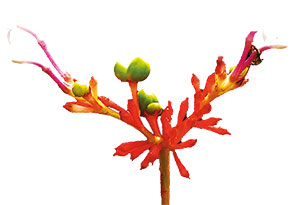 Sarpagandha
Sarpagandha
Sarpagandha, botanically known as Rauvolfia serpentine, is a Red-listed medicinal plant. That means it’s a rare endangered plant especially in Karnataka, Kerala and Tamil Nadu. Sarpagandha is a native, perennial, evergreen undershrub, which reaches a height of one metre. The plant grows in clusters of exuberant blooms.
Sarpagandha is an eye-catching plant with white flowers and reddish floral parts. It can pretty up any dull garden and convert a boring landscape into a glorious green-white one. This plant is a great backdrop for a lawn garden.
The roots of the Sarpagandha are used for treating hypertension, fever, wounds, sleeplessness, epilepsy, and giddiness. The plant grows in Himachal Pradesh, Arunachal Pradesh, the Western and Eastern Ghats as well as Eastern and Central India.
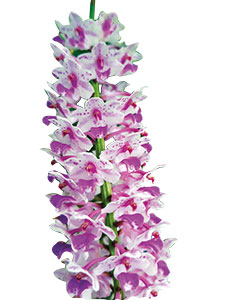 Kopou Phool
Kopou Phool
This lovely Foxtail orchid is known as Kopou Phool in Assam. It plays an important part in the culture of the Assamese people and hence has been adopted as the State Flower of Assam.
All orchids are stunningly beautiful. But Kopou Phool, or Rhynchostylis retusa, is special because it also has medicinal qualities. An epiphytic orchid, it is famed for its marvellous, long-lasting blooms. Epiphytic orchids have special types of roots called velamen roots through which atmospheric moisture and nutrients are absorbed. This species can be found hanging on to tree trunks. Numerous flowers on drooping stalks makes it look like a flowery waterfall. Pendulous long racemes entwined around tree trunks look as if the trees have been decorated with glorious garlands! The roots of the Foxtail orchid are traded in the name of ‘rasna’ and used to treat rheumatism.
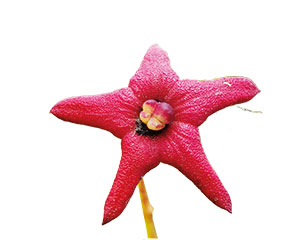 Tube Flower
Tube Flower
The Tube Flower is a species that grows to a height of three metres. It is known for its abundant foliage and flowers. The flower has whorls of three in each node. The inflorescences are strikingly large, up to 20 cm long and 10 cm broad. The flowers are white and fruiting calyx are star-shaped, red and very attractive. The fruits are blue and splendid to look at. This shrub grows very fast and can be planted in tall hedges since it cannot be clipped from the top or in beds of shrubs or in a stand-alone pot in your balcony, deck or terrace. In Ayurveda, this species is recommended for improving blood circulation. It is good for digestive disorders and bronchial complaints.
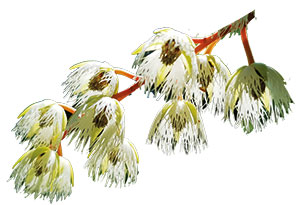 Indian Olive Tree
Indian Olive Tree
The Indian Olive tree (Elaeocarpus serratus L.) or wild olive tree, is the cousin of the Rudraksh tree. It grows in the Western Ghats and in the Northeastern hills. In most Indian languages this tree is known as Ekamukhi Rudraksh because of the shape of its nuts. However, in Arunachal Pradesh, Assam and West Bengal it is called Jalpai or Zolphai.
The fruits of the Indian Olive Tree are extensively used in the preparation of tasty pickles. In Arunachal Pradesh the raw fruits are eaten. The fruits are reported to possess medicinal properties against diarrhoea and dysentery. The tree also attracts various species of pollinators.
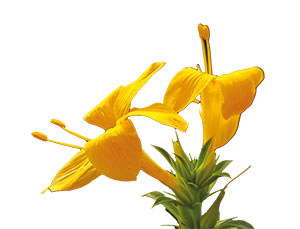 Vajradanti
Vajradanti
Vajradanti is well-known as one of the prime species used to guard the teeth against any infection and strengthen the gums. It is evident from the name Vajradanti which means diamond teeth as depicted in ancient Ayurvedic texts. The leaves are chewed to strengthen the gums and to protect the teeth against decay. Vajradanti is scientifically known as Barleria prionitis L. It belongs to the December flower family, Acanthaceae.
Vajradanti is a bushy shrub with many branches. It grows to a height of 2.5 metres. Vajradanti’s stems are armed with spines and its inflorescences consist of beautiful orange-yellow flowers surrounded by green leafy bracts. The plant’s dark green, shiny leaves create a wonderful contrast to its flowers, making this a very attractive shrub. In English, it is popularly known as the porcupine flower.
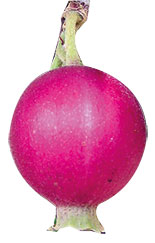 Ankolam Tree
Ankolam Tree
Ankolam or Azhinjil, or Alangium salvifoium, is one of the most auspicious and worshipped trees in India. Traditionally, a piece of the stem of this tree is kept at the entrance of the house not only to prevent the entry of evil spirits but also to bring goodness and cheer to the family. Ankolam is also well known for its antidotal properties especially against several types of poisonous bites.
It is a small, deciduous tree with a pale brown bark with shallow cracks. Ankolam has spiny branchlets that provide safety and therefore attract nesting birds. Anyone who calls himself or herself a lover of birds should have this tree in their garden. The tree has flowers that are white or yellowish-white and fragrant. The berries, 2/1 cm, globose to ellipsoid, are orange-red when ripe and look beautiful. They are sweet and edible.
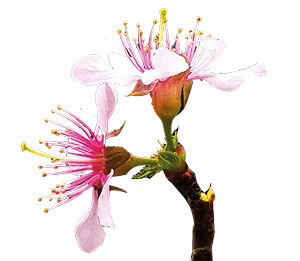 Wild Himalayan Cherry
Wild Himalayan Cherry
The Wild Himalayan Cherry Tree or the Bird Cherry Tree (Prunus cerasoides) is a moist deciduous tree which reaches 25 metres in height. The tree’s bark is strikingly glossy with a ringed, peeling-off bark. This tree has a single stout trunk hence it can be used to create a focal point in the garden. With its beautiful bark, stunning flowers and edible fruit, the Wild Himalayan Cherry Tree is a visual treat throughout the year. The tree flowers profusely. The bark is used for plastering fractured bones and its steam is used for treating vomiting, leprosy and leucoderma.
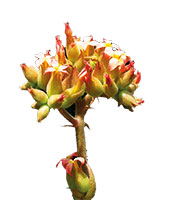 Kalanchoe
Kalanchoe
Kalanchoe grandiflora plants are thick-leaved succulents. An amazing herb, it grows to one metre and bears splendid foliage. The inflorescence is short and compact with many strikingly beautiful flowers, yellow and orange-yellow in colour. The cheery clusters of blooms can render a spectacular look to gardens, balconies and terraces. This native species can be the best substitute for the popular, ornamental jade plant. It can be grown even in dry regions with poor, rocky soils. This species is used to treat bruises, wounds, boils and arthritis. It is also a potential substitute for pashanbhed, a well-known Indian herb used to dissolve kidney stones.
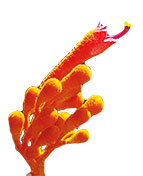 Bonfire Tree
Bonfire Tree
The Scarlet Sterculia or the Bonfire Tree, also known as Sterculia colorata Roxb, is a medium-sized tree with beautiful, large, showy leaves. Its tender leaves are spectacular. This deciduous tree sheds leaves in winter but its flower buds arise immediately after its leaves fall. Its orange-yellow flowers are dramatic as they quickly grow from bare stems. The whole inflorescence including the tree’s stalks are covered with colourful velvety hair. Since its flowers are large and showy, the tree adds a brilliant look to gardens and avenues.
The Bonfire Tree is a comparatively rare tree found occasionally in the Deccan hills, in the lower altitude of the Western Ghats and in parts of Assam, Meghalaya, Odisha, Madhya Pradesh. The Bonfire Tree is used in Ayurveda, homoeopathy and folk medicine for urinary disorders, mental problems and jaundice.
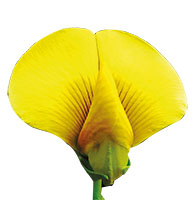 Rattlepod
Rattlepod
The Rattlepod or Crotalaria retusa L., is a herb which reaches one metre in height and has many, clearly radiating branches near the ground. The appeal of this unique herb lies in its extraordinary inflorescence that attracts numerous pollinators especially colourful butterflies. The Rattlepod can be grown in containers too. Every end of its branches is ornamented with 30-cm inflorescences with amazing yellow flowers. Its large petals look elegant with purplish lines and pinkish-orange backs. These flowering branches slowly transform into rattle sticks with many inflated attractive pods. These pods on maturity turn black and create an amusing sound when shaken. According to ethnobotanical studies this herb is used against poisoning, fever and respiratory complaints.
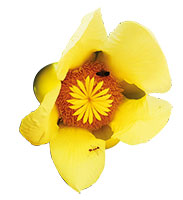 Elephant Apple Tree
Elephant Apple Tree
The Elephant Apple Tree or Dilleniaindica L. is a large evergreen reaching 30 metres in height. The characteristic features to identify this tree in the field are its ranchlets which have V-shaped leaf-scars. The Elephant Apple Tree’s leaves are strikingly large and prominently corrugated with impressively imprinted veins. The tree's flowers are conspicuously big, up to 20 cm across, and very showy, with huge white pendant masses of stylar branches surrounding deep golden yellow stamens and petals.
These trees will look absolutely spectacular in avenues and in landscaped gardens. The tree’s fruits are large, up to 12 cm across, unique and technically a false-fruit where the yellowish-green sepals play the role of mimicking fruits. Seeds are many and embedded in fibrous, edible pulp. These fruits are reported to be a good source of food for herbivores especially for mega herbivores such as elephants and hence the name ‘elephant apple’.
The tree grows in moist forests almost throughout India. Known as Bhavya in Ayurveda, it is used to tackle respiratory and central nervous system disorders and also considered to be a digestive drug.
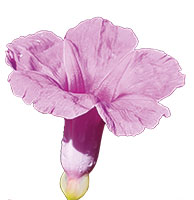 Giant Potato
Giant Potato
The Giant Potato or Ipomoea mauritiana Jacq plays a prime role in providing better health to women. The Giant Potato is a tuber-bearing vine with beautiful bell-shaped, pinkish-purple flowers belonging to the Morning Glory family, Convolvulaceae. Its flowers are pinkish-purple, funnel-shaped, up to 6 cm across with narrow tubes five cm long.
The Giant Potato usually grows in open areas in moist deciduous forests. It has also been found in riparian vegetation, lowland forests and in grasslands throughout warmer parts of India. It is also cultivated for its medicinal tubers. The tubers are used to moderate menstrual discharge and often prescribed to increase secretion of breast milk. The Giant Potato is also prescribed in case of debility after delivery and to increase weight.
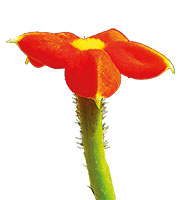 Flag Bush
Flag Bush
Plants of ornamental value are generally grown in gardens to increase the aesthetic features of landscapes. The ornamental features of such plants may not necessarily be flowers but could also be brightly coloured foliage, curious looking fruits, unusual forms and textures of barks/stems and so on. Mussaendafrondosa L., belonging to family Rubiaceae, is one such wild beauty that can be spotted even at a distance due to its very shining, large, leaf-like floral part. In English, it is called Flag Bush or White Lady.
This wild beauty’s leaves and flowers are crushed and applied externally to heal wounds. Its shining leaf-like bracts are boiled in water and the water is used as shampoo for cleansing hair. It is also used in the treatment of jaundice. The juice of the plant is used to treat eye infections. The decoction of the leaves can be taken orally to get rid of intestinal worms. Bellila is a common plant which grows in moist deciduous forests and in the evergreen forests of the Western Ghats.
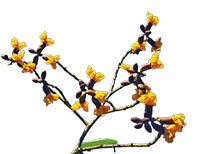 Benga Tree
Benga Tree
Indian tradition is known for its close connect with nature and the respect it accords to Mother Earth. In this tradition, nature is seen as superior to man. Trees are held in high esteem. One such tree which is deeply appreciated is the Benga Tree also known as Pterocarpus marsupium Roxb, belonging to the family Fabaceae.
The Benga Tree reaches a height of 18 metres. Its trunk and branches exude a bright red resin. The tree’s bark is rough and longitudinally fissured. Inflorescences are panicles, terminal or axillary, up to 15 cm long. The Benga’s flowers are two cm across and golden yellow. The bright yellow flowers interspersed with dark-coloured flower buds and stalks resemble a tiger’s coat, hence the name Vengai in Tamil and Venga in Malayalam. In English it is known as the Indian Kino Tree. Kino means medicinal resin. This resin is used for the treatment of bleeding and diarrhoea. The tree’s bark is extensively used to tackle diabetes. Its leaves treat various skin problems. The tree is found in mixed jungles and in the dry deciduous forests of southern and central India.
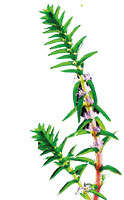 Fringed Flower
Fringed Flower
The Fringed Flower or Rotala aquatica Wight, is a nectar yielding species. Known as an ‘amphibious’ herb since it can grow both in shallow water bodies and on land, this slender herb with its creeping stems and rooting usually at lower nodes, bears gorgeous flowers. The Fringed Flower with semi-succulent, shining, four-angled stems has tiny leaves. Loads of fringed pink flowers are a feast for the eyes especially against sunlight. This flower forms a lovely ground cover holding down soil and gentle marshy slopes. Emerging between little boulders, the species can also be exploited as an alternative to grasses.
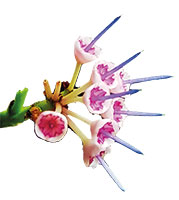 Anjani
Anjani
Anjani in Marathi or Memecylon umbellatum Burm.f. is one of the most beautiful trees during flowering. It is a small tree, reaching 25 feet, which blooms twice a year. Anjani puts forth dazzling heads of bright blue flowers amidst colourful clusters of flower buds. This small tree can be used to create lovely focal points in smaller spaces. The flower highlights walkways in landscapes when planted on both sides. It is used to treat gonorrhoea. It is known as the Delek Air Tree in English.
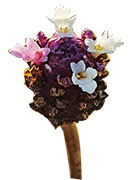 Jala Pippali
Jala Pippali
Phyla nodiflora (L.) Greene, popularly known as Jala Pippali in Ayurveda, is a marshy plant that grows at the edges of water bodies. It is found almost throughout India. Jala Pippali is often grown ornamentally as a ground cover plant. The plant’s inflorescence consists of a purple centre encircled by small white-to-pink flowers on the periphery and thus mimics a matchstick. Hence it is often called 'match weed' ! Interestingly, this wetland species does not demand much water. It is a perfect choice for any style of garden.
You can grow this plant not only for its beauty but also to harvest ‘pippalis’ (inflorescences) for their gentle curative properties as a hair tonic. These beautiful inflorescences can be enjoyed almost throughout the year. Jala Pippali can be planted in hanging pots, allowing its stems and flowers to droop and create a splendid look!
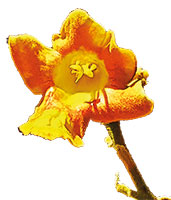 Gambhari
Gambhari
Gambhari (Gmelina arborea Roxb) is popularly known as white teak in English. Gambhari is a handsome, fast-growing, moderately-sized deciduous tree reaching 20 metres in height. This tree is leafless from February to April but is adorned with bunches of lovely flowers, which are large and yellowish-brown, on branched panicles. The flowers produce enormous amounts of nectar, helping in producing high
quality honey.
Gambhari is native to India. It is found in the sub-Himalayan tracts and in Uttar Pradesh, Punjab, Dehradun, Odisha, West Bengal, Assam, Madhya Pradesh and southern India. The leaf juice is considered a good mouthwash to treat ulcers. The flowers and fruits are beneficial for treating leprosy, anaemia, ulcers and constipation. The flowers are also believed to be aphrodisiacs and are used as a hair tonic too.
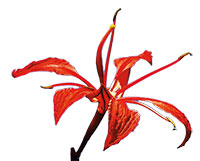 Scarlet Bauhinia
Scarlet Bauhinia
The Scarlet Bauhinia or Bauhinia phoenicea is endemic to the southern Western Ghats (Karnataka, Kerala and Tamil Nadu). This vine has been assigned red or ‘vulnerable’ status by the International Union for Conservation of Nature (IUCN).
It is an exuberant, fast-growing climber which climbs up to 20 m. As a heavy climber, it needs strong support and should not be planted with other slender vines. Sprawled on compound walls, it brings an earthy feel to a house. The brightly-coloured, tender leaves with prominent reticulations of veins are particularly eye-catching. The beauty of the scarlet flowers makes this climber iconic to landscapes. This native liana adds fabulous speckling and unusual morphology to gardens, transforming them into tropical bouquets.
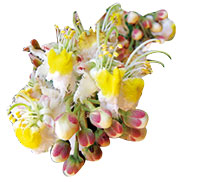 Madhavi Latha
Madhavi Latha
Hiptage benghalensis (L.) Kurz, traditionally known as Madhavi Latha, is a perennial evergreen liana. It is native to India. Madhavi Latha has shiny green foliage, white fringed petals and one median yellow petal, creating a wonderful burst of colour.
The flowers bloom abundantly and intermittently throughout the year and emit a mild fragrance too. This climbing species can help cover less attractive spots and is ideal for large spaces as it sprawls all over quickly! Though it is a liana, it can be clipped to form a small tree with very little canopy. White petals with bright yellow petals in the centre contrast with its shiny green backdrop, making it a picturesque climber. Being a dominant species indicating dry areas and a type of salt-tolerant soil, it can be grown in drought-prone areas as well as in coastal climates. Its fruits are samaras with three spreading, papery wings that help seed dispersal on the wind. It is useful in treating cuts and wounds, relieving burning sensations, bronchial complaints, coughs and ulcers.
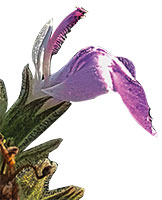 Maha Drona
Maha Drona
Maha Drona, scientifically known as Anisomeles malabarica (L.) R. Br. ex Sims, belongs to the Lamiaceae family, or the mint/basil family. Maha Drona reaches a height of one to two metres. Its stems are four-angled and blunt, white and hairy. Flowers are pink with white streaks or entirely white, up to two cm long.
Maha Drona is reportedly one of the best remedies for knee pain. The leaves of the Maha Drona are filled in half a mud pot and gingelly oil is poured into three-fourths of the pot. The mouth of the pot is tied with a cotton cloth and kept in a sunny place for a month. After 30 days the Maha Drona leaves soaked in oil are heated and the warm oil is applied gently on the knees. Maha Drona is a moderate shrub which looks nice in any garden. It can also be placed in containers to flank front doors or patio steps. It attracts tiny birds and butterflies too.
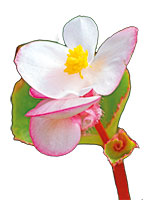 Begonia
Begonia
Begonia malabarica Lam, belonging to its own family Begoniaceae, is a beautiful and sturdy houseplant that can be planted in shaded summer beds since it is not finicky about being outdoors. Unlike other native wild plants it is ideal for indoor environments and can even add colour to bathrooms as this species loves humidity!
Tuberous begonias will die every year but the wild one doesn’t. It offers attractive, year-round asymmetrical foliage with colourful streaks on dark green leaves and stunning seasonal male and female flowers. Its deep red colour beneath its leaves makes it adored by plant lovers. As an outdoor garden plant, native begonia can be used as a colourful and compact edging for flower beds or to ornament window boxes and fill hanging baskets.
This is the only species with leaves that have all five different tastes. When chewed, its leaves are first sour followed by bitter, sweet, pungent and finally an astringent taste! The leaves are used to treat blood cancer, heart diseases, skin infections, diarrhoea and respiratory complaints.
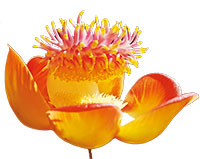 Kailash Taru
Kailash Taru
Sacred trees are usually planted in and around temples or places of pilgrimage. The tree which is planted at the heart of the temple is known as Sthala Vruksha or sacred element. One such sacred tree is Kailash Taru or Nagalinga Pushpa. It is believed that the Kailash Taru has been in India for more than 3,000 years. It is scientifically known as Couroupita guianensis Aubul and belongs to the family Lecythidaceae.
This tree is known for its unusual flowers and fruits. The main trunk is ornamented with hundreds of drooping racemes with fragrant flowers which are large, showy, 6-10 cm long, yellowish-red outside and pink inside. The tree’s flowers produce two types of stamens — the fertile ring stamens and the sterile stamens on hood-like structures. In Hindu mythology, the hooded sterile stamens are seen as 100-headed snakes and the style at the centre is seen as a Shivalinga, hence the local name Naga-Lingapushpa. The bark, leaf and flower have medicinal properties and are used for scorpion stings, dysentery, piles, scabies and other skin diseases.
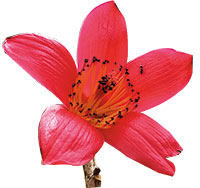 Shalmali
Shalmali
Shalmali or Bombax malabarica L. is a huge tree with a straight trunk which reaches 25 metres. It is usually found in India’s deciduous forests. Shalmali is a gloriously tall tree, native to India, which flowers abundantly and blooms profusely in summer. It has large, showy, scarlet flowers which appear before its leaves sprout on the branches. Hence, during flowering it is leafless! While in bloom it has a profusion of red lotus flowers adding pizazz to any landscape.
Shalmali’s unripe fruit, green in colour, mimic the size and shape of unripe bananas. Its tap root, bark, gum, flowers, fruit, seeds and silk cotton are used against dysentery, diarrhoea, piles, cough, menorrhagia and leucorrhoea. The cotton obtained from its fruit capsules is used in pillows to induce better sleep. Shalmali’s common name is red silk cotton tree.
Comments
Currently there are no Comments. Be first to write a comment!



